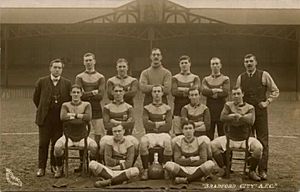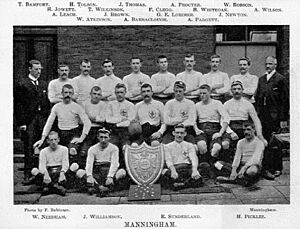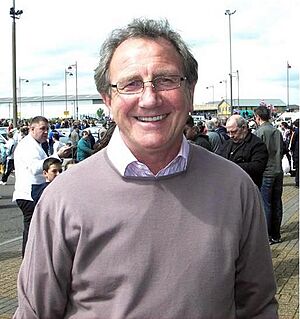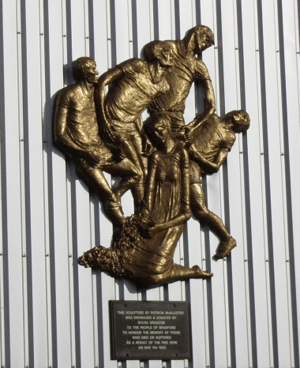History of Bradford City A.F.C. facts for kids
Bradford City Association Football Club, often called Bradford City, is an English football team. It was started in Bradford in 1903. The club was created to bring football to an area that mostly played rugby league. Even before their first game, City joined the Football League. They took over Valley Parade stadium, which has been their home ever since.
The club won the Division Two title in 1908. They also won the FA Cup in 1911. Both wins happened when Peter O'Rourke was manager. City was later moved down from Division One in 1922.
Five seasons later, City was moved down again. But when O'Rourke became manager again in 1928, they broke club records. They earned promotion back to Division Two. After eight seasons there, City went back to Division Three. They stayed in the third and fourth levels of English football until 1986. During this time, the club faced money problems. In 1985, their stadium had a terrible fire. Many people died on a day that was supposed to be a celebration.
In 1988, the club almost returned to the top division. They missed out on promotion on the very last day. After moving back to Division Three, things improved. Geoffrey Richmond became chairman in 1994. He helped the club reach Wembley for the first time. Then, they made it to the Premier League, playing there for two seasons. After some financial issues, the club faced problems. They dropped through the leagues. City went back to the lowest professional league. But in 2013, they earned promotion again. In January 2013, City became the first fourth-tier club since 1962 to reach the Football League Cup final.
Contents
Early Successes (1903–1919)
Football leagues began in West Riding of Yorkshire in 1894. In 1903, a newspaper editor named James Whyte met with a Football Association official. They talked about starting a Football League club in Bradford. Manningham F.C. was a rugby league club. They decided to switch to playing association football. The Football League wanted to bring football to this rugby-focused area. So, they chose the club, now called Bradford City, to join the league.
Bradford City became the first league football team from the county. This happened even before they had a team or played a game. They and Chelsea are the only clubs to join the league without playing a match first. Money for the new club came from a summer archery contest. The club kept Manningham's claret and amber colours. But they changed the hoops to stripes.
Robert Campbell became the club's first manager. The team bought players for about £917. Their first game was a 2–0 loss to Grimsby Town in September 1903. Their first home game was six days later. It was against Gainsborough Trinity. About 11,000 fans watched, including the Lord Mayor of Bradford. City won their first game against Burton United. They finished 10th in Division Two that season.
In November 1905, Peter O'Rourke became manager. He was one of the club's players. He led City to 11th and then 5th place. In 1908, they earned promotion to Division One. The season started with an 8–1 win over Chesterfield. They had six more big wins. Promotion and the title were secured in April.
Before their first Division One season, Bradford City toured Europe. They won against German and Belgian clubs. But their first league win in the top division took five tries. It was a 4–1 victory over Bury. This was their only win in the first 14 games. Results got better later in the season. A 1–0 win against Manchester United on the last day saved them from being moved down.
The next season, Bradford finished seventh. But the 1910–11 season was their best ever. Their fifth-place league finish is still the club's highest. They also won the FA Cup. They beat Newcastle United 1–0 in the 1911 final. This is the club's only major trophy. Early cup wins came from goals by Dicky Bond. He missed the last four games due to a club suspension. One of these was a 1–0 win over Burnley. This game had 39,146 fans, still Valley Parade's highest attendance.
The biggest win was a 3–0 victory over Blackburn Rovers in the semi-finals. City fans traveled to the final in London on 11 special trains. The game against Newcastle at Crystal Palace was a 0–0 draw. It was called "dull and uneventful." A replay was needed. It happened four days later in Manchester. A single goal from Jimmy Speirs in the 15th minute gave Bradford a 1–0 win. They were the first to win a new trophy, made by Bradford jewellers.
Bradford's FA Cup defense ended in the fourth round. They lost 3–2 to Barnsley. This ended a record of 11 clean sheets in the FA Cup. The cup run included the first Bradford derby against Bradford (Park Avenue). In the league, City finished 11th. This was the first of four mid-table finishes. League football stopped because of the First World War. Many footballers, including City's FA Cup hero Speirs, died in the war.
Between the Wars (1919–1938)
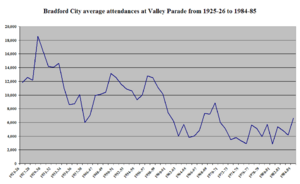
After the war, many players had retired. So, a new team played in the 1919–20 season. City finished 15th in the league. This was their lowest finish since their first Division One season. They were knocked out of the FA Cup in the fourth round. The next season, they finished 15th again. After ten seasons in Division One, City was moved back to Division Two. They lost their last five games of the 1921–22 season. It would be 77 years until Bradford City played in the top division again.
O'Rourke left as manager in 1921. Bradford's results suffered in Division Two. Both Bradford City and Bradford (Park Avenue) were moved down in 1922. Fan numbers in Bradford dropped. City's average attendance fell from a high of 22,585 in 1920–21. It went down to between 12,000 and 14,000 in Division Two. Five seasons of low finishes led to them being moved down to Division Three (North) in 1927. They finished last after an 8–0 loss to Manchester City.
New manager Colin Veitch almost led the club to immediate promotion. They finished sixth. But at the end of the season, players had not been paid. The club had money problems. If fans had not donated money, Bradford City might not have played the next season. A new board was chosen. They brought Peter O'Rourke back as manager. Success came quickly. The 1928–29 season started with a record 11–1 win over Rotherham United. The team scored a club record 128 goals. They earned promotion by just one point. City's successful team also brought fans back. The average attendance of 18,551 is the highest recorded by the club since 1925.
O'Rourke left for a second time in May 1930. He resigned because he could not sign a player he wanted. City spent eight seasons back in Division Two. They almost reached the top league in 1933–34. At one point, they were at the top of the division. Their sixth-place finish was their highest since being in Division One. They would not do better until the 1980s. They were moved back to Division Three (North) in 1936–37. City was second in the Division Three North Challenge Cup a year later. They won the same competition in the last year before league football stopped again for World War II.
Lower Divisions (1946–1981)
New manager Jack Barker only stayed for eight months. He was replaced by Jack Milburn in 1946. Milburn led City to fifth place in his first season. But he only stayed for one more season. Only one team was promoted from Division Three (North) each season. So, City stayed at that level. In 1958, the league changed. City was placed in Division Three. This was after finishing third the season before, their highest in 20 years.
In 1960, part of the stadium's Midland Road stand was closed. This was after checks on the foundations. The whole stand was closed, leaving only three stands. After just three years in Division Three, City dropped into Division Four in 1960–61. But that season, they beat Division One team Manchester United in their first ever League Cup game.
City had a club record 9–1 loss to Colchester United in December 1961. But they finished fifth in 1961–62. This was thanks to David Layne's 34 league goals. This is still a club record for a season. But they missed promotion by just one point. Layne left for Sheffield Wednesday. City finished 23rd the next season. They had to apply to stay in the league.
In 1966, the club moved the pitch closer to the main stand. This made space for a new standing area. All four stands were open for the first time since 1960. Fan numbers kept dropping. A new low of 1,353 fans was set in May 1966. This led chairman Stafford Heginbotham to hold a meeting. They raised new money to save the club. The team's mixed results continued. They almost got promoted twice. Then, they earned promotion in 1968–69. The season before, City had three managers. Grenville Hair died just two months into his time as manager.
Striker Bobby Ham scored 18 goals. He helped City get into Division Three. He was again top goalscorer the next season. But the club's time in Division Three was short. Ham and fellow Bradford-born striker Bruce Bannister left. City was moved back to the bottom division in 1971–72. Ces Podd also made his debut during this time. He played a record 502 league games for the club.
City spent five seasons back in Division Four. In 1975–76, they had their best FA Cup run in over 50 years. They beat Norwich City. They were knocked out in the quarter-finals by Southampton. A year later, over 40 goals from Joe Cooke, Terry Dolan, and Don Hutchins helped City get another promotion. They finished fourth. The club's board did not make the team stronger. So, they went straight back to Division Four. Under new manager George Mulhall, City spent three seasons in the middle of the table.
Bantam Progress (1981–1990)
In May 1981, City hired former England player Roy McFarland as their new manager. The 1981–82 season started with a loss and a draw. But City then went to the top of the table. They had nine league wins in a row, matching a 30-year club record. This run ended against Sheffield United. Over 13,700 fans watched at Valley Parade. This brought in a club record of £17,938. Cold weather meant City played only once in December. But they were back at the top of Division Four in January. City finished second, five points behind Sheffield United. They were promoted back to Division Three.
Three months into the next season, McFarland and his assistant Mick Jones resigned. They left for Derby County. Derby had to pay a large fine and money to City for taking them. Chairman Bob Martin hired another England player, Trevor Cherry. He came from Leeds United. Cherry and assistant Terry Yorath continued to build on McFarland's work. This time was later called "Bantam Progressivism." Even though they did not win for over two months, they led City to 12th place.
The club had money problems again. In June 1983, Martin called in financial help. The club was put up for sale. A "Save Bradford City Fund" was started. Former chairman Stafford Heginbotham and Jack Tordoff bought the club. They formed a new company. This allowed the team to start the new season. Striker Bobby Campbell was sold to Derby County to help with money. John Hawley was brought in to replace him.
City struggled on the field. They won only one of their first 15 games. They were in the relegation zone. Campbell had played only 11 games for Derby. So, he returned to Bradford on loan. His return led to a club record ten league wins in a row. Campbell finished the season with nine goals, Hawley with 22. But City finished seventh and missed promotion.
The good form continued the next season. From October to December 1984, City had a 13-match unbeaten run. During this time, Campbell became the club's all-time leading goalscorer. He broke a 70-year-old record. City went to the top of the division. They kept their lead, being 11 points ahead by February. Promotion was secured in April. The club won its first championship title since 1929. This happened after a 2–0 win over Bolton Wanderers.
This success was overshadowed by a terrible event. A fire broke out in Valley Parade's main stand. This happened 40 minutes into the last game of the season on May 11, 1985. Many people died. The club did not play another game at Valley Parade for almost 20 months.
City played home games at other stadiums during the 1985–86 season. They finished 13th. They also played away from home for the first half of the 1986–87 season. They returned to Valley Parade on Boxing Day 1986. The stadium had been rebuilt for £2.6 million. Cherry was dismissed ten days after the return. He had managed the team through tough times. Club coach Terry Dolan became manager. He led the team away from relegation. They finished 10th.
By September 1987, Dolan's team was at the top of Division Two. This was for the first time in 54 years. They finished fourth after a loss on the final day. They missed promotion after losing in the play-offs. Key players Stuart McCall and John Hendrie left. Within two seasons, City dropped back to Division Three. In January 1988, Stafford Heginbotham resigned as chairman due to health reasons.
Richmond Era and Modern Times (1990 onwards)
For three seasons, City finished in the middle of Division Three. The leagues were renamed after the Premier League was formed. In January 1994, Geoffrey Richmond became chairman. He paid off the club's debts. He also loaned the club £2.3 million. He promised fans he would take the club to the Premier League within five years. In his first season, the club finished seventh. Frank Stapleton was manager. Stapleton was fired and replaced by Lennie Lawrence. Lawrence finished 14th in his first season. He left in November 1995. His assistant Chris Kamara took over.
Kamara helped the team get a play-off spot. They won on the final day against Hull City. City then beat Blackpool in the play-off semi-finals. The final against Notts County was City's first game at Wembley. Goals from Des Hamilton and Mark Stallard gave them a 2–0 win. This secured promotion to Division One. Kamara used 42 players in 1996–97. City avoided being moved down with a 3–0 win in the final game. Kamara was fired in January 1998. Richmond said the manager had taken the club as far as he could.
Richmond again promoted from within. Paul Jewell, who had been at the club since 1988, became manager. He was made full-time in May 1998. Richmond gave him millions to buy players. Jewell signed strikers Lee Mills and Isaiah Rankin. He also signed former captain Stuart McCall. Despite a bad start, the club earned promotion to the top division. This was for the first time in 77 years. They won 3–2 against Wolverhampton Wanderers in the final game of the 1998–99 season.
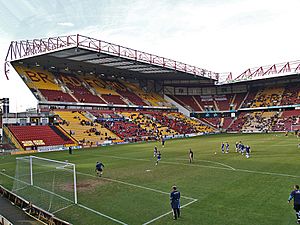
City's success meant Dean Windass became the club's third £1 million signing. Jewell broke the club's transfer record again. He paid £1.4 million for David Wetherall. Jewell also added other experienced players. The media called his team "Dad's Army." When City beat Middlesbrough 1–0, Dean Saunders mocked the critics. City did not win another game until their eighth of the season. A TV expert said they would be moved down. He promised to shave his hair if they avoided it. A run of nine home games without defeat gave City hope. They avoided relegation on the final day of the season. A 1–0 win over Liverpool and Wimbledon's loss meant City survived. They did so with a record low of 36 points.
Less than two months after City stayed up, Jewell left. He joined Sheffield Wednesday. His assistant, Chris Hutchings, replaced him. The club played in the Intertoto Cup. This was their first time in a European competition. They lost to FC Zenit Saint Petersburg in the semi-finals. Richmond gave Hutchings more money than Jewell to spend. Bradford paid a club record £2.5 million for David Hopkin. They also paid £1.5 million for Ashley Ward. They signed Italian striker Benito Carbone for £40,000 a week. Richmond also continued to rebuild the stadium. Its capacity increased to 25,136. Richmond later called his spending "six weeks of madness."
In their second Premier League season, City struggled. Hutchings was fired after only one win in 12 league games. Under new manager Jim Jefferies, the club could not avoid being moved down. This was confirmed with a 2–1 loss to Everton. They finished the season with just 26 points.
Jefferies was fired in December 2001. This was after an argument with captain McCall. Nicky Law became his replacement. The club finished 15th. That summer, the club had nearly £13 million in debt. This was due to a TV channel collapsing and Richmond's spending. The club had to go into administration. All players were released. But Carbone gave up much of the money he was owed. This helped the club survive under new owners Julian Rhodes and Gordon Gibb. City played their games in the 2002–03 season. But they finished 19th.
Former England captain Bryan Robson became the new manager. But under him, City won only seven games out of 28. They were moved down in 23rd place. Robson left and his assistant Colin Todd replaced him. The club went into administration a second time. But Todd led them to 11th place in the next two seasons. Fans put pressure on the club. After a bad run of results, Rhodes fired Todd in February 2007. City was just three points above the relegation zone. Wetherall became player-manager temporarily. City was moved down after a 3–0 loss to Chesterfield.
In summer 2007, former player Stuart McCall returned as manager. City was in the lowest league for the first time in 25 years. He aimed to get promotion back to League One in his first season. But he missed promotion twice. He left the club in February 2010. City was 16th in League Two.
In January 2013, City made history. They became the first fourth-tier club since 1962 to reach the Football League Cup final. They were also the first fourth-tier club to reach a major cup final at Wembley. They beat three Premier League teams to get there. They beat Wigan Athletic, Arsenal, and Aston Villa. They played Premier League team Swansea City in the final at Wembley. They lost 0–5.
In May 2013, the club returned to Wembley. They beat Northampton Town 3–0 in the League Two play-off final. This secured them a place in League One for 2013–14. On January 24, 2015, Bradford City caused a big surprise. They beat Premier League leaders Chelsea 4–2 away in the FA Cup. This win sent Bradford to the fifth round for the first time in 18 years. There, they beat another top-flight team, Sunderland. This got them to their first FA Cup quarter-final since 1976. It was in front of their biggest home crowd in 50 years. Bradford was knocked out in the quarter-final by Reading after a replay.
The team finished last in the 2018–19 season. They were moved back to League Two. In December 2021, American investors tried to buy the club. The offer was rejected. On February 24, 2022, former Wales manager Mark Hughes became the club's manager. He signed a contract until summer 2024.


